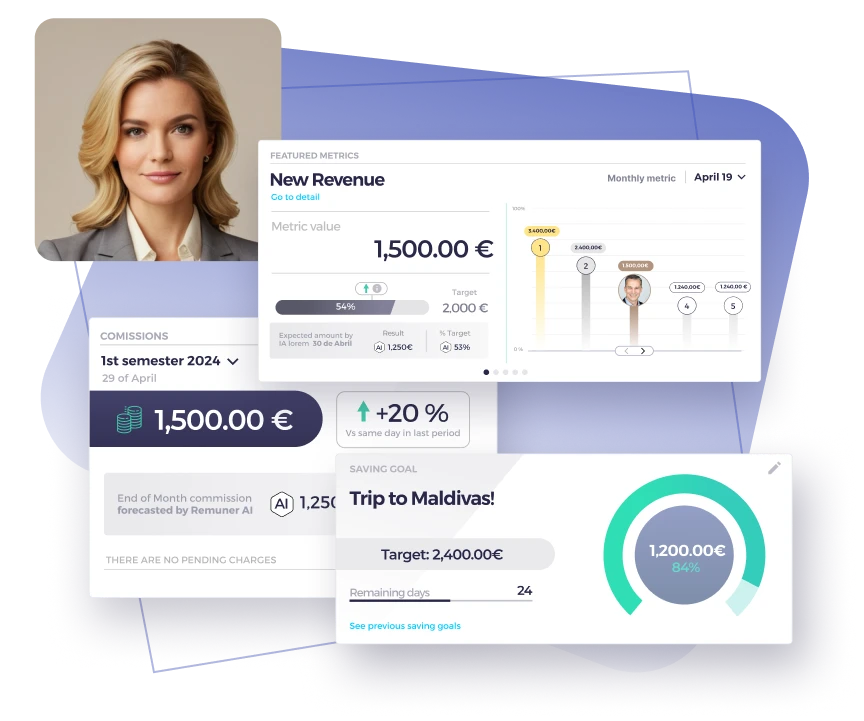Table of contents
A strong sales incentive plan can drive your sales team’s performance, boost motivation, and align your revenue goals with actionable targets. When implemented effectively, a sales incentive plan not only ensures that your sales reps are motivated but also contributes directly to achieving and exceeding business objectives.
In this article, we will explore the components of a sales incentive plan, how to structure one for maximum results, and examples of how businesses use these plans to improve sales performance.
What is a sales incentive plan?
A sales incentive plan is a structured program designed to reward sales reps or teams for meeting specific goals. These goals could range from achieving a revenue target, closing a specific number of deals, or retaining long-term customers. By tying rewards to measurable performance, companies align individual motivation with company objectives.
Sales incentives are an essential part of any compensation plan. They motivate your sales team, increase engagement, and encourage high-performing individuals to exceed expectations.
Why your business needs a sales incentive plan
An effective sales incentive plan brings multiple benefits for sales managers:
- Improves sales performance: Setting clear sales goals tied to rewards pushes your team to achieve results.
- Motivates team members: Well-crafted incentives encourage effort, loyalty, and long-term dedication.
- Aligns teams with company objectives: Role-specific incentives ensure that all team members contribute to broader business goals.
- Attracts and retains talent: Top performers seek companies with transparent and attractive compensation plans.
By implementing split incentives or customized reward systems, companies ensure that their sales force remains engaged throughout the sales process.
Types of sales incentive plans: Which One is Right for You?
When creating a sales incentive plan, you need to choose the type of incentive that fits your business goals. Here are the main types of sales incentive plans based on commission structures:
1. Commission-based incentives:
Sales reps earn a percentage of the revenue from each sale. This is common for businesses that rely heavily on closing deals quickly.
Example: A SaaS company offers 5% commission on all new customer sales.
2. Quota-based incentives:
Reps receive rewards after achieving their pre-determined quota within a specific time frame.
Example: Sales reps who hit 100% of their quota receive an extra $2,000 bonus.
3. Role-specific incentives:
Designed for team members in specific roles, such as account executives or customer success managers, to address their goals.
Example: Account managers receive rewards for increasing customer retention by 10%.
4. Team-based incentives:
Rewards are distributed based on team performance, encouraging collaboration.
Example: If the team achieves $1M in revenue, all members receive a $1,000 bonus.
5. Long-term incentive plans:
Incentives like equity, profit sharing, or bonuses encourage sustained performance over time.
6. Activity-based incentives:
These rewards motivate behaviors that lead to sales success, like booking demos or qualifying leads.
Example: A sales rep receives $50 for each qualified lead they pass to the next stage.
By combining multiple types of incentives, businesses create a holistic approach that motivates every team member.
How to design a winning sales incentive plan
Building a successful sales incentive plan requires a structured approach. Follow these steps to create a sales process that drives results:
- Define clear sales goals
Start with well-defined sales goals that align with your company’s objectives. These can include revenue growth, customer acquisition, or retention targets. Goals must be realistic, measurable, and achievable. - Set role-specific incentives
Tailor incentives to different roles in the sales process. Account executives, sales development reps, and customer success managers all have unique goals. Role-specific incentives ensure fair and effective motivation. - Determine your compensation plan structure
Decide how incentives will fit into your overall compensation plan. Combine fixed salaries with performance-driven rewards like commissions or bonuses. - Incorporate split incentives for collaboration
Split incentives encourage teams to collaborate by distributing rewards across multiple roles. For instance, if two team members work on a deal, both receive a portion of the reward. - Keep it simple and transparent
Sales incentive schemes must be easy to understand. Sales reps should know how incentives are calculated and how they can achieve their goals. - Leverage analytics-based performance tracking
Use real-time data to track performance and ensure accurate compensation. With tools that monitor quotas and sales performance, businesses maintain transparency and fairness. - Reward both short-term and long-term performance
Combine short-term rewards (like monthly bonuses) with long-term incentives (like profit sharing or equity) to drive sustained success. - Test and optimize your incentive plan
Evaluate the effectiveness of your sales incentive program regularly. Collect feedback from your sales force and adjust the plan to align with performance outcomes.

Examples of sales incentive plans
To bring the concept to life, here are some real-world examples of effective sales incentive plans:
1. Tech company boosting new customer acquisition
A technology company sets a quarterly quota of $200,000 in revenue. Sales reps receive a $5,000 bonus for meeting the quota, with an additional $2,000 if they surpass it by 20%. This plan motivates the sales team to aim higher while rewarding strong performance.
2. SaaS business focusing on customer retention
Customer success managers receive a split incentive: 50% of their reward is tied to retention metrics, while 50% is linked to upselling existing customers. This aligns their efforts with both maintaining and expanding revenue.
3. E-commerce sales incentives
An e-commerce business offers activity-based incentives. Sales reps earn $50 for each qualified lead they generate and an additional 3% commission on all sales. By combining activities with rewards, the company drives both lead generation and conversions.
4. Split incentives for team collaboration
A company implementing split incentives ensures the sales process runs smoothly. If a sales development rep books a meeting that results in a closed deal, both the SDR and the account executive share the reward.
Common mistakes to avoid
Even with good intentions, poorly designed incentive plans can lead to confusion or demotivation. Here are common pitfalls to avoid:
- Unrealistic quotas: Goals must be challenging yet achievable. Unrealistic targets will demoralize your sales force.
- Complicated incentive structures: Overly complex plans confuse reps and hinder their ability to focus on sales goals.
- Ignoring long-term performance: Focus on sustainable success, not just short-term wins.
- Lack of transparency: Reps need visibility into their quotas, rewards, and performance to stay motivated.
How to evaluate and improve your sales incentive plan
Improving your sales incentive program requires regular evaluation. Use the following methods:
- Gather team feedback: Ask sales reps what works and what doesn’t in the current incentive structure.
- Analyze performance metrics: Use analytics to track results and measure how incentives influence sales performance.
- Adjust based on outcomes: Optimize your incentive plans to ensure they drive the desired behaviors.
By continuously refining your compensation plan, you ensure it remains aligned with business growth.
Apply it to your company
A well-designed sales incentive plan motivates your sales team, aligns performance with business goals, and improves overall sales performance. By choosing the right type of incentive, setting clear sales goals, and maintaining transparency, you can create a program that inspires your sales force to exceed expectations.
Whether you implement quota-based incentives, role-specific rewards, or long-term incentive plans, the key lies in driving both individual and team success. Monitor performance, gather feedback, and continuously improve your sales incentive program to keep your team performing at its best.
To streamline this process, leverage tools like Remuner, a leading sales compensation software. Remuner combines the power of incentive compensation software and sales incentive software to automate your entire incentive plan management. As a comprehensive sales performance software, it helps you design, communicate, and optimize sales incentive plans with real-time data and AI-based coaching. Maximize transparency, alignment, and motivation across your teams effortlessly.





